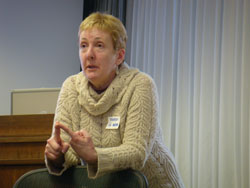Meetings and Events
Spring 2013
Vol. 8, Issue 1
Winter 2013
Vol. 7, Issue 2
Spring 2012
Vol. 7, Issue 1
Spring 2011
Vol. 6, Issue 1
Fall 2011
Vol. 6, Issue 2
Spring 2010
Vol. 5, Issue 1
Fall 2010
Vol. 5, Issue 2
Spring 2009
Vol. 4, Issue 1
Fall 2009
Vol. 4, Issue 2
Spring 2008
Vol. 3, Issue 1
Fall 2008
Vol. 3, Issue 2
Fall 2007
Vol. 2, Issue 2
Winter 2007
Vol. 2, Issue 1
Summer 2006
Vol. 1, Issue 2
CAM Information
OCCAM on the Web
Social media applications are ubiquitous in our culture. Facebook, Twitter, YouTube, Second Life, countless blogs, and thousands of Web sites barrage us with up-to-the-second news about everything from what we ate for lunch, to politics and health care. According to the Pew Internet and American Life Project 6 out 10 people living with cancer have Internet access, and 1 in 5 Internet users that have cancer use social network sites1.
YouTube, an online video community, is a Web site where users can watch and upload videos 24 hours a day. NCI, realizing the power of this medium to help spread information about cancer treatments and prevention, created its own YouTube channel. The NCI YouTube channel, http://www.youtube.com/ncigov, launched in August 2009, is the NCI’s official conduit for cancer information videos. Videos include information for patients on how to participate in clinical trials, topic updates from NCI staff, and in-depth profiles of key cancer researchers.
Dr. Jeffrey D. White, director of the Office of Cancer Complementary and Alternative Medicine, shares a message on complementary and alternative medicine (CAM) and cancer with consumers in a YouTube video. The video, available at http://www.youtube.com/ncigov, highlights the importance of talking to your doctor about your use of CAM, common concerns about CAM use, and resources to check for further information. This video is the first in what will eventually become a series of cancer CAM videos produced by NCI. Check back often for more videos on CAM as well as other cancer topics.
1Fox, S. (2009, Oct.5) Research on e-patients and the use of social media for health. Pew Research Center’s Internet and American Life Project. Retrieved, April 9, 2010 from http://www.pewinternet.org/Presentations/2009/29--PatientCentered-Learning-and-the-Health-20-Movement.aspx.
New Federal Resources on CAM
Herbal Dietary Supplements: Examples of Deceptive or Questionable Marketing Practices and Potentially Dangerous Advice
Government Accountability Office (GAO)
Recent studies have shown that use of herbal dietary supplements — chamomile, echinacea, garlic, ginkgo biloba, and ginseng — by the elderly within the United States has increased substantially. Sellers, such as retail stores, Web sites, and distributors, often claim these supplements help improve memory, circulation, and other bodily functions. GAO was asked to determine (1) whether sellers of herbal dietary supplements are using deceptive or questionable marketing practices and (2) whether selected herbal dietary supplements are contaminated with harmful substances. The results of the GAO investigation are available in the following report: http://www.gao.gov/products/GAO-10-662T.
Guidance from an NIH Workshop on Designing, Implementing, and Reporting Clinical Studies of Soy Interventions.
National Institutes of Health
The NIH-sponsored workshop, "Soy Protein/Isoflavone Research: Challenges in Designing and Evaluating Intervention Studies," held on July 28-29, 2009, provided guidance for the next generation of soy protein/isoflavone human research. Session topics included population exposure to soy; the variability of the human response to soy; product composition; methods, tools, and resources available to estimate exposure and protocol adherence; and analytical methods to assess soy in foods and supplements and analytes in biologic fluids and other tissues. The intent of the workshop was to address the quality of soy studies, not the efficacy or safety of soy. Prior NIH workshops and an evidence-based review questioned the quality of data from human soy studies. If clinical studies are pursued, investigators need to ensure that the experimental designs are optimal and the studies properly executed. The workshop participants identified methodological issues that may confound study results and interpretation. Scientifically sound and useful options for dealing with these issues were discussed. The resulting guidance is presented in this Journal of Nutrition article with a brief rationale. The guidance is specific to soy clinical research and does not address nonsoy-related factors that should also be considered in designing and reporting clinical studies. This guidance may be used by investigators, journal editors, study sponsors, and protocol reviewers for a variety of purposes including designing and implementing trials, reporting results, and interpreting published epidemiological and clinical studies.
http://www.ncbi.nlm.nih.gov/pubmed/20392880
Antioxidant Supplements for Health: An Introduction
National Center for Complementary and Alternative Medicine
This fact sheet provides a general overview of antioxidants – with a focus on dietary supplements – and suggests sources for additional information.
http://nccam.nih.gov/health/antioxidants/
Join Us for the Summer and Fall 2010 Lectures

speakers such as Dr. Sandra M. Gaston in March 2010.
Antiangiogenic Properties of Sweet Tea
Dr. Zhijun Liu, Medicinal Plant Lab, Louisiana State University Agricultural Center
July 14, 2010
Melatonin and Breast Cancer
Dr. Stephen Hill, Department of Structural and Cellular Biology, Tulane University School of Medicine
August 11, 2010
Effect of GCS-100, a polysaccharide derived from citrus pectin, on Lymphoma Cells
Dr. Linda Baum, UCLA School of Medicine
September 8, 2010
Methylselenocysteine and Colon Cancer
Dr. Youcef Rustum, Roswell Park Cancer Institute
October 13, 2010
Anti-inflammatory and Anticancer Activity of Vitamin E Forms and Their Metabolites
Dr. Qing Jiang, Purdue University
November 10, 2010
More information about past and future lectures is available on the OCCAM Web site.
Sign-up for OCCAM’s Listserv
Stay up-to-date on the latest cancer CAM news at NCI with OCCAM’s listserv, OCCAM Announcements. As a listserv subscriber, you will receive a monthly email about upcoming workshops and lectures, new funding opportunities, publications, and other resources. To subscribe, simply visit OCCAM’s Web site:





